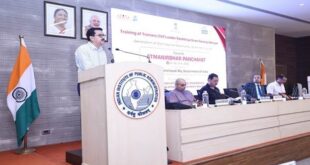- Recently, the Union Minister of Law and Justice informed the Rajya Sabha regarding the appointment of judges in various high courts.
- The minister pointed out that filling up vacancies in the higher judiciary is a continuous, integrated and collaborative process between the Executive and the Judiciary.
- It requires consultation and approval from Constitutional authorities at the State as well as Central level.
Important points:
- Article 217 of the Constitution: It states that the Judge of a High Court shall be appointed by the President in consultation with the Chief Justice of India (CJI), the Governor of the State
- In the case of appointment of a Judge other than the Chief Justice, the Chief Justice of the High Court is consulted.
- Consultation Process: High Court judges are recommended by a Collegium comprising the CJI and two senior-most judges.
- The proposal, however, is initiated by the Chief Justice of the High Court concerned in consultation with two senior-most colleagues.
- The recommendation is sent to the Chief Minister, who advises the Governor to send the proposal to the Union Law Minister.
- The Chief Justice of the High Court is appointed as per the policy of having Chief Justices from outside the respective States.
- The Collegium takes the call on the elevation.
- The appointment of retired judges was provided for in the Constitution under Article 224A.
- Under the Article, the Chief Justice of a High Court for any State may at any time, with the previous consent of the President, request any person who has held the office of judge of that court or of any other High Court to sit and act as a judge of the High Court for that State.
- Recently, the Supreme Court pushed for the appointment of retired judges to battle the pendency of cases in High Courts.
- It orally outlined prospective guidelines for the appointment and functioning of an ad-hoc judge.
Collegium System:
- It is the system of appointment and transfer of judges that has evolved through judgments of the SC, and not by an Act of Parliament or by a provision of the Constitution.
- First Judges Case (1981): It declared that the “primacy” of the Chief Justice of India (CJI) recommendation on judicial appointments and transfers can be refused for “cogent reasons.”
- The ruling gave the Executive primacy over the Judiciary in judicial appointments for the next 12 years.
- It added that it was not the CJI’s individual opinion, but an institutional opinion formed in consultation with the two senior-most judges in the SC.
- Third Judges Case (1998): SC on President’s reference expanded the Collegium to a five-member body, comprising the CJI and four of his senior-most colleagues (for example for the transfer of HC judges).
Issues:
- There are inordinate delays in the appointment of High Court judges and depleting numbers in the higher judiciary threaten to affect the justice delivery mechanism.
- The absence of formal criteria has multiple worrying implications.
- Presently, there is no structured process to investigate if a judge who is recommended by the collegium has any conflict of interests.
- The collegium system structurally tends to favour particular sections of society and is far from being representative of the population for whom it seeks to deliver justice.
- The total sanctioned strength of judges across the 25 high courts is 1,098 but the working strength is only 645, a shortfall of 453 judges.
- The total pendency of cases in the several courts of India at different levels, sums up to a total of about 3.7 crores thus increasing the demand of a better and improved judicial system.
Way Forward
- It is time to think of a permanent, independent body to institutionalize the process with adequate safeguards to preserve the judiciary’s independence guaranteeing judicial primacy but not judicial exclusivity.
- It should ensure independence, reflect diversity, demonstrate professional competence and integrity.
SOURCE: THE HINDU,THE ECONOMIC TIMES,MINT
 Chinmaya IAS Academy – Current Affairs Chinmaya IAS Academy – Current Affairs
Chinmaya IAS Academy – Current Affairs Chinmaya IAS Academy – Current Affairs



